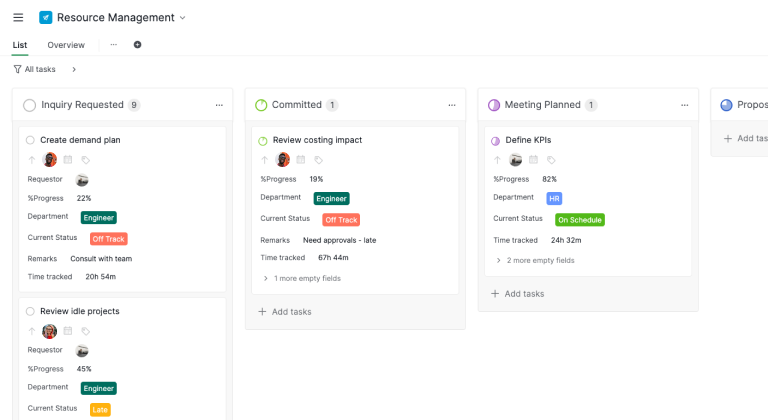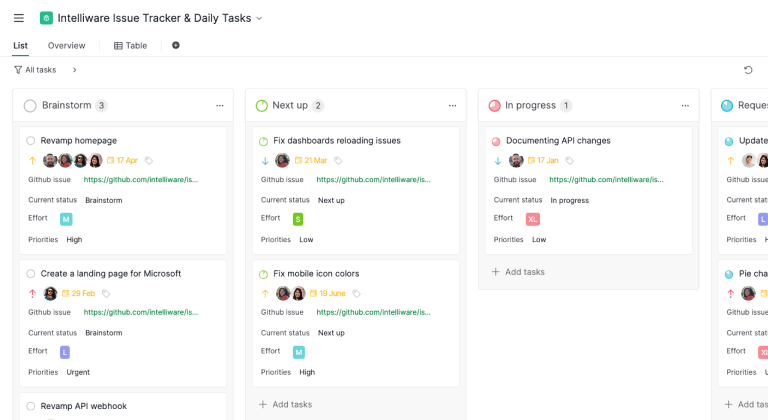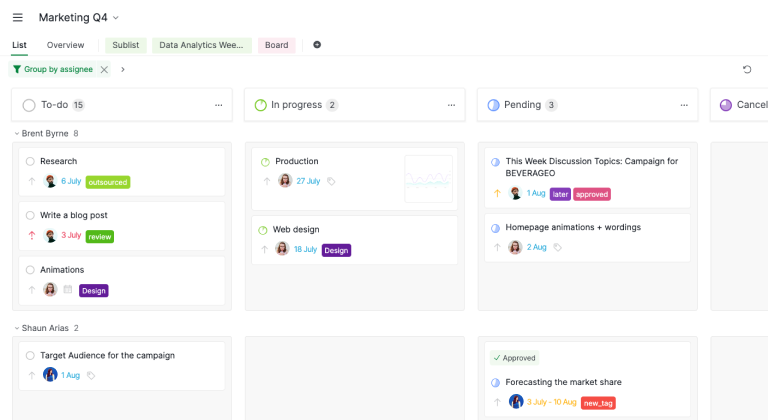project management · Aug 1, 2024
The 4 Core Kanban Principles and 5 Best Practices

In today's high-pressure business world, efficient project management is the key to getting things done. Enter Kanban, a visual method that's helping teams everywhere be more productive and deliver projects smoothly.
This post dives into the heart of Kanban: what it is, its core principles, the benefits it brings, and why these principles are crucial for project success. We'll also answer some common Kanban questions to get you started.
What is a Kanban Board?
A Kanban board is a visual tool that helps teams manage their work by displaying tasks and statuses clearly and organized. The board typically consists of columns representing different stages of the workflow, such as "To Do," "In Progress," and "Done." Each task or work item is represented by a card, which moves across the columns as it progresses through the workflow.
The simplicity and visual nature of Kanban boards make them highly effective for tracking tasks, identifying bottlenecks, and ensuring that team members are aligned on the status of ongoing projects. By providing a real-time snapshot of the project status, Kanban boards facilitate better communication and collaboration among team members, leading to improved efficiency and productivity.
The 4 Core Kanban Principles

Kanban is built on four core principles that guide its implementation and usage. These principles are:
1. Visualize Work
The first principle of Kanban is to visualize work. This involves creating a visual representation of the workflow and its tasks. By using a Kanban board with columns such as "To Do," "In Progress," and "Done," and color-coded cards to signify different task types or priorities, teams can see all tasks at a glance.
This setup helps them understand the current status of each task and recognize any potential issues that may arise. Visualization makes the workflow transparent and comprehensible, enabling better decision-making and coordination among team members.
2. Limit Work in Progress (WIP)
The second principle is to limit work in progress (WIP). This means setting a cap on the number of tasks that can be in progress at any given time. By limiting WIP, teams can focus on completing tasks before starting new ones, which helps in reducing multitasking and improving the flow of work.
Without WIP limits, teams might spread their efforts across too many tasks, leading to delays and reduced quality. By contrast, limiting WIP highlights bottlenecks and areas where the workflow may be getting stuck, allowing teams to address these issues promptly and maintain a smoother, more efficient process.
3. Manage Flow
The third principle is to manage the flow. This involves monitoring the movement of tasks through the workflow to ensure that work is progressing smoothly and efficiently. For example, in a software development project, the team regularly reviews the Kanban board to track the progress of tasks from "To Do" to "In Progress" and finally to "Done."
If they notice that tasks are getting delayed in the "Testing" column, they can investigate and address the issue, perhaps by allocating more resources to testing. By regularly reviewing the flow of tasks, teams can identify any delays or disruptions and take corrective actions to maintain a steady and predictable workflow. Managing flow is essential for maintaining a consistent pace of work and delivering value to customers promptly.
4. Continuous Improvement
The fourth principle of Kanban is continuous improvement, also known as Kaizen. This principle emphasizes the importance of regularly reviewing and improving the workflow and processes.
By fostering a culture of continuous improvement, teams can identify areas for enhancement, implement changes, and measure their impact. Continuous improvement helps in optimizing the workflow, increasing efficiency, and ensuring that the team is always striving for better performance.
5 Benefits of Using Kanban Board

Implementing a Kanban board offers several benefits that can significantly enhance project management and team productivity. These benefits align closely with the core principles of Kanban: visualizing work, limiting work in progress (WIP), and managing flow. Here are five key benefits:
1. Enhanced Visibility
Kanban boards provide a clear and visual representation of the workflow, making it easy for team members to see the status of tasks and understand the overall progress of the project.
For instance, by visualizing work through columns and color-coded cards, team members can immediately grasp what needs to be done and what is currently being worked on.
This visibility helps in improving communication and collaboration, as everyone is aware of the project's status and any potential issues.
2. Improved Efficiency
By limiting work in progress and focusing on completing tasks before starting new ones, Kanban boards help teams work more efficiently.
For example, a marketing team using WIP limits can concentrate on completing a campaign before starting a new one, reducing multitasking and ensuring timely delivery of value to customers. This principle of limiting WIP enhances overall efficiency and speeds up the workflow.
3. Better Identification of Bottlenecks
Kanban boards make it easy to spot bottlenecks and areas where the workflow may be getting stuck. By managing flow and regularly reviewing the movement of tasks through the workflow, teams can quickly identify delays, such as a task that is stalled in the "In Progress" column.
Identifying these issues early allows teams to take corrective actions, ensuring a smooth and uninterrupted flow of work.
4. Increased Flexibility
Kanban boards are highly adaptable and can be customized to fit the specific needs of any team or project.
This flexibility allows teams to adjust their workflow and processes as needed. For example, a software development team can modify its board to include new columns or adjust WIP limits based on the project's requirements, making it easier to respond to changes and challenges.
5. Continuous Improvement
The emphasis on continuous improvement in Kanban helps teams regularly review and enhance their workflow and processes.
By managing flow and continuously seeking ways to improve, teams can implement small, incremental changes that lead to significant improvements over time.
This focus on Kaizen ensures that the team is always looking for ways to optimize their work, leading to increased efficiency and productivity.
By incorporating these principles and benefits, Kanban boards provide a comprehensive framework for effective project management, ensuring that teams can deliver high-quality results consistently and efficiently.
Four Kanban Best Practices for Teams
To further enhance the effectiveness of Kanban boards, teams can adopt additional best practices. These practices build on the core principles and help optimize workflow management. Here are five more Kanban best practices:
1. Use Visual Signals
Employ visual signals, such as tags, icons, or colored stickers, to convey additional information about tasks.
For instance, tags can indicate the priority level, type of work (e.g., bug fix, feature development), or dependencies. This helps team members quickly understand the context and requirements of each task, improving communication and decision-making.
2. Conduct Regular Reviews
Hold regular review sessions, such as weekly or bi-weekly reviews, to assess the overall progress and health of the project. During these reviews, analyze metrics like throughput, cycle time, and lead time to identify trends and areas for improvement.
Regular reviews ensure that the team remains aligned with project goals and can make timely adjustments to the workflow.
3. Encourage Team Collaboration
Foster a collaborative environment where team members actively participate in managing the Kanban board. Encourage everyone to update task statuses, move cards, and provide input on workflow improvements.
When team members are involved in these activities, it ensures that the board accurately reflects the current state of work, and everyone remains engaged in the process. This active participation promotes a sense of ownership and accountability, enhancing communication and collaboration, as team members work together to keep the workflow efficient and address any issues promptly.
4. Prioritize Tasks Effectively
Implement a clear prioritization strategy to ensure that the most important tasks are addressed first. Use visual cues or separate columns for high-priority tasks to distinguish them from others.
Regularly review and adjust priorities based on changing project needs and stakeholder feedback. Effective prioritization helps the team focus on delivering the most value.
By incorporating these additional best practices, teams can further refine their use of Kanban boards, leading to more efficient and effective project management. These practices help optimize workflow, enhance collaboration, and ensure that the team remains focused on delivering high-quality results.
Why We Need The Kanban Principles to Improve Our Project Management
The Kanban principles are essential for improving project management for several reasons:
1. Clarity and Transparency
By creating a visual representation of tasks and their progress, Kanban principles make the workflow transparent. This means everyone on the team can easily see the current status of tasks and any potential issues.
This clarity and transparency are crucial for effective communication and collaboration, which are key components of successful project management.
2. Focus and Prioritization
Limiting work in progress helps teams focus on completing tasks before taking on new ones, which reduces multitasking and ensures that high-priority tasks are addressed promptly.
This focus and prioritization are vital for maintaining a steady flow of work and delivering value to customers promptly.
3. Proactive Problem Solving
Managing flow and continuously improving the workflow enables teams to identify and address bottlenecks and inefficiencies early.
This proactive approach to problem-solving helps in maintaining a smooth and predictable workflow, which is essential for meeting project deadlines and goals.
4. Adaptability
The flexibility of Kanban boards allows teams to adapt their workflow and processes as needed, making it easier to respond to changes and challenges.
This adaptability is crucial for managing projects in a dynamic and ever-changing business environment.
5. Continuous Improvement
The focus on continuous improvement ensures that teams are always looking for ways to enhance their workflow and processes. This commitment to Kaizen leads to increased efficiency, productivity, and overall performance, which are critical for the success of any project.
FAQs for Kanban Principles and Practices

What is the main purpose of a Kanban board?
The main purpose of a Kanban board is to visualize the workflow and tasks within a project, making it easier for teams to track progress, identify bottlenecks, and ensure that work is moving smoothly through the workflow.
How does limiting work in progress (WIP) improve efficiency?
Limiting work in progress helps teams focus on completing tasks before starting new ones, which reduces multitasking and ensures that work is completed more efficiently. This leads to faster delivery of value to customers and a more predictable workflow.
Can Kanban be used for any type of project?
Yes, Kanban is highly adaptable and can be used for a wide range of projects, from software development to marketing campaigns and beyond. The principles and practices of Kanban can be customized to fit the specific needs of any team or project.
How often should teams review and update their Kanban board?
Teams should regularly review and update their Kanban board to ensure that it accurately reflects the current status of tasks and the overall progress of the project. This could be done during daily stand-up meetings, weekly reviews, or as needed based on the specific workflow and project requirements.
What are some common challenges of implementing Kanban?
Some common challenges of implementing Kanban include resistance to change, difficulty in setting appropriate WIP limits, and ensuring that all team members are consistently updating the board. Addressing these challenges requires effective communication, training, and a commitment to the Kanban principles and practices.
Kanban: Your Key to Project Management Nirvana
Kanban isn't just a fancy board, it's a powerful project management system. By seeing the work, limiting WIP (work in progress), managing flow, and constantly improving, your team becomes a well-oiled machine.
Kanban boards bring transparency, helping you spot bottlenecks a mile away. Plus, flexibility is built-in so that you can adapt to changing priorities. The best part? Kanban works for any size team. So, ditch the chaos, embrace Kanban, and watch your projects soar!


